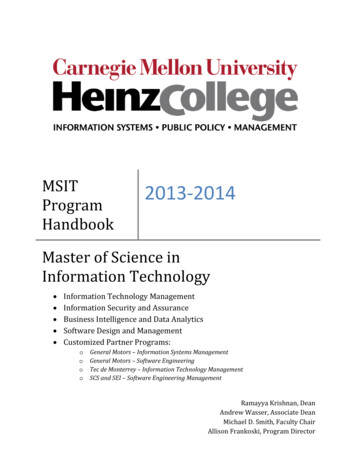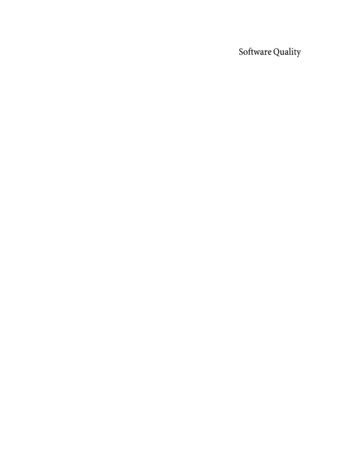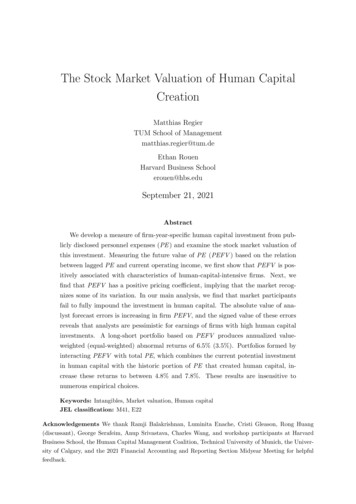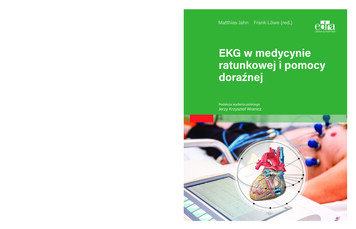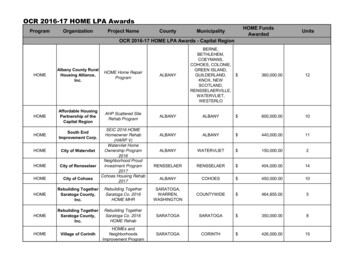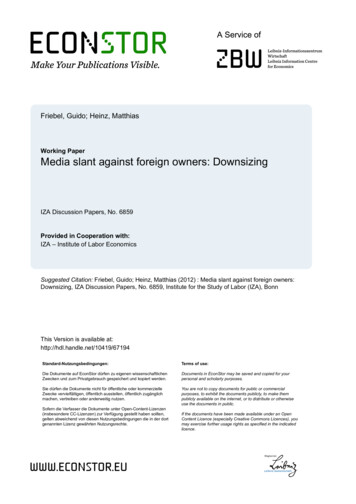
Transcription
Friebel, Guido; Heinz, MatthiasWorking PaperMedia slant against foreign owners: DownsizingIZA Discussion Papers, No. 6859Provided in Cooperation with:IZA – Institute of Labor EconomicsSuggested Citation: Friebel, Guido; Heinz, Matthias (2012) : Media slant against foreign owners:Downsizing, IZA Discussion Papers, No. 6859, Institute for the Study of Labor (IZA), BonnThis Version is available ngsbedingungen:Terms of use:Die Dokumente auf EconStor dürfen zu eigenen wissenschaftlichenZwecken und zum Privatgebrauch gespeichert und kopiert werden.Documents in EconStor may be saved and copied for yourpersonal and scholarly purposes.Sie dürfen die Dokumente nicht für öffentliche oder kommerzielleZwecke vervielfältigen, öffentlich ausstellen, öffentlich zugänglichmachen, vertreiben oder anderweitig nutzen.You are not to copy documents for public or commercialpurposes, to exhibit the documents publicly, to make thempublicly available on the internet, or to distribute or otherwiseuse the documents in public.Sofern die Verfasser die Dokumente unter Open-Content-Lizenzen(insbesondere CC-Lizenzen) zur Verfügung gestellt haben sollten,gelten abweichend von diesen Nutzungsbedingungen die in der dortgenannten Lizenz gewährten Nutzungsrechte.If the documents have been made available under an OpenContent Licence (especially Creative Commons Licences), youmay exercise further usage rights as specified in the indicatedlicence.
SERIESPAPERDISCUSSIONIZA DP No. 6859Media Slant Against Foreign Owners: DownsizingGuido FriebelMatthias HeinzSeptember 2012Forschungsinstitutzur Zukunft der ArbeitInstitute for the Studyof Labor
Media Slant Against Foreign Owners:DownsizingGuido FriebelGoethe University Frankfurt,CEPR and IZAMatthias HeinzGoethe University FrankfurtDiscussion Paper No. 6859September 2012IZAP.O. Box 724053072 BonnGermanyPhone: 49-228-3894-0Fax: 49-228-3894-180E-mail: iza@iza.orgAny opinions expressed here are those of the author(s) and not those of IZA. Research published inthis series may include views on policy, but the institute itself takes no institutional policy positions.The IZA research network is committed to the IZA Guiding Principles of Research Integrity.The Institute for the Study of Labor (IZA) in Bonn is a local and virtual international research centerand a place of communication between science, politics and business. IZA is an independent nonprofitorganization supported by Deutsche Post Foundation. The center is associated with the University ofBonn and offers a stimulating research environment through its international network, workshops andconferences, data service, project support, research visits and doctoral program. IZA engages in (i)original and internationally competitive research in all fields of labor economics, (ii) development ofpolicy concepts, and (iii) dissemination of research results and concepts to the interested public.IZA Discussion Papers often represent preliminary work and are circulated to encourage discussion.Citation of such a paper should account for its provisional character. A revised version may beavailable directly from the author.
IZA Discussion Paper No. 6859September 2012ABSTRACTMedia Slant Against Foreign Owners: Downsizing *We establish the existence of strong media slant against foreign owners. Using a unique dataset from nation-wide distributed quality newspapers in Germany, we find that a foreign firmthat downsizes in Germany receives almost twice as much attention than a domestic firm.This quantitative slant is accompanied by qualitative slant; newspapers report in a morenegative way about downsizing foreign than domestic firms. The slant is present in all qualitynewspapers, but it increases from right to left in the political spectrum. This is consistent withtheory papers arguing that slant is an equilibrium phenomenon. The slant we document is aclean measure for economic xenophobia; however, not geared against migrants, but againstforeign owners. The slant can be a substantial obstacle to FDI, as illustrated by case studies.Our results are likely to be a lower bound estimate, because Germans are ratherglobalization-friendly and we are looking at quality papers, not tabloids.JEL Classification:Keywords:L82, L33, L10media economics, globalization, economic xenophobia,multi-national enterprises, foreign direct investmentCorresponding author:Guido FriebelGoethe University FrankfurtChair of Human Resource ManagementP.O. Box 52Grüneburgplatz 160629 FrankfurtGermanyE-mail: gfriebel@wiwi.uni-frankfurt.de*We thank Simon Anderson, Iwan Barankay, Sascha Becker, Stefan Bender, Paolo Cox, StefanoDellaVigna, Klaus Desmet, Ruben Durante, Karolina Ekholm, Ruben Enikolopov, Matthew Gentzkow,Lisa George, Fabrizio Germano, Maria Guadalupe, Sergei Guriev, Peter Haan, Andrea Ichino, NielsKemper, Joep Konings, Michael Kosfeld, Olga Kuzmina, Christian Leuz, Alexander Lipponer, MarcAndreas Muendler, Volker Nocke, Maria Petrova, Riccardo Puglisi, Isabell Schnabel, Andrei Shleifer,Monika Schnitzer, Eugene Soltes, David Strömberg, Jo Swinnen, Natalya Volchkova, Joel Waldfogel,Jörgen Weibull, Ekaterina Zhuravskaya and seminar participants in Frankfurt, KU Leuven andStockholm School of Economics for their comments. We also thank conference audiences at thethEuropean Economic Association Meeting in Oslo 2011 and the 9 Workshop on Media Economics inMoscow 2011. We are grateful to MediaTenor and YouGov for access to data.
1. IntroductionUsing a unique data set on nation-wide distributed quality newspapers in Germany, weestablish the existence of strong media slant against foreign owners. On average, firms thatare controlled by foreign blockholders attract close to double the media attention for each jobshed than domestic firms. More articles are written about downsizing when owners areforeign, and in an average article, more of the words written concern downsizing rather thanfirm performance, products or strategies. Quantitative slant is accompanied by qualitativeslant; newspapers report more negatively about downsizing in foreign-owned firms.Our estimates are likely to be a lower bound of media slant against foreign owners,because Germany is a leading export country (second to China only), Germans are among thepeoples most positive about globalization (on a level that is above the one of the U.S.2), andbecause we look at quality not regional newspapers or tabloids.The slant we find is a clean measure of economic xenophobia, here, geared againstforeign owners rather than targeting the most likely victims of economic xenophobia,migrants. When moving from right to left on the political spectrum of newspapers, the slantagainst foreign owners increases. The slant is likely to cause severe obstacles to FDI and,thus, global inefficiencies. Foreign firms that anticipate negative media attention and penaltiesby domestic consumers will price in the risk, leading to discounts in the case of FDI.Foreigners may even refrain from buying firms that are candidates for downsizing orsubstantial media interest. These implications are testable, although we are lacking the data.In Section 2, we do, however, provide short case studies that give an idea of the multi-millionpenalty consumers can inflict on a downsizing foreign firm.In the remainder of the Introduction, we explain how the data were generated andanalyzed, and how our findings relate to empirical and theoretical work in media economics.Most importantly, we argue that our paper may be among the first to empirically supportsome of the leading theories on the industrial organization of media, in particular, SendhilMullainathan and Andrei Shleifer (2005) and Matthew Gentzkow and Jesse Shapiro (2006).Our first data set is based on 5,394 articles from Germany’s center-right newspaperDie Welt on a total of 651 downsizing events in Germany between December 2000 andSeptember 2008.3 Following Gentzkow’s and Shapiro’s (2006) definition of slant, we focuson the varying intensity of reporting a given fact, measured by the number of words the2Cf Anna-Maria Mayda and Dani Rodrik (2005).We end with September 2008, because the collapse of Lehman Brothers triggered a wave ofdownsizing and state interventions, and we are interested in normal, rather than special times.23
newspaper writes per job shed in downsizing events of foreign-owned employers, relative todomestic ones. A second data set from the media consultancy Media Tenor allows to measurethe different qualitative evaluations involved. We also collected a third data set that includesall articles on downsizing during five randomly chosen months from all nation-widedistributed quality newspapers in Germany.To build the first data set we developed an algorithm that excludes both the errors ofincluding “false” and failing to include “real” downsizing cases (explained in detail in Section3). Our regressions (Section 4) show a strong media slant against foreign-owned firms; it isrobust against the inclusion of a battery of control variables, such as 40 sectors, 16 regions,time dummies, or size of the downsizing firm. The absolute magnitude of downsizing and itsimportance relative to firm size cannot explain the slant either.Interestingly, the slant against foreign firms is stronger when the region’sunemployment rate in which the downsizing occurs is higher. Local unemployment does,however, not matter for the intensity of reports on domestic firms’ downsizing activities.Investigating potential spurious correlations (in Section 5) we find that the results arerobust against inclusion of the reason for downsizing (off-shoring, M&A etc), the type ofownership (publicly listed, private-equity owned etc), and the country of origin of the owners.The newspaper has no tendency to report more about foreign firms in general, or aboutpositive news like job creation, i.e. upsizing of foreign-owned firms.The slant is unrelated to technological factors, like the size of standard articles indifferent newspapers sections such as title page, business and economics, politics, or to thetiming of the news, as in Eugene Soltes (2009). We also use matching techniques as in SaschaBecker and Andrea Ichino (2002) and Paul Rosenbaum and Donald Rubin (1983) to makesure that the effects are not caused by endogenous sorting of foreign firms in specific regionsor sectors that may receive more attention.If foreign firms downsized more intensively than domestic firms, there could be arationale for media to report more on “foreign” downsizing, for instance, to make peopleaware of the higher risk of losing one’s job. Most of the FDI literature does, however, not findevidence that foreign multi-national enterprises (MNEs) are more footloose than domesticones.4 Christine Borrmann, Rolf Jungnickel and Dietmar Keller (2003) find that foreign firmsare similar to domestic firms in terms of participation in collective bargaining and employing4Giorgio Barba Navaretti and Anthony Venables (2004), Claudia Buch and Alexander Lipponer(2010).3
works councils. They have similar turnover rates and similar shares of part-time and fixedterm contract workers.A notable exception is Becker and Marc-Andreas Muendler (2010) who document thatGerman MNEs tend to adjust at the intensive margin in Western Europe, but rather at theextensive margin in Central and Eastern Europe. Because almost all firms in our sample areMNEs, with roughly one third controlled by foreign blockholders, we can investigate whetherthe slant is driven by a similar firm behavior of foreign firms at the extensive margin.5Looking at the closure of establishments (the extensive margin), we do not find any effects.There is thus little reason to believe that foreign firms behave differently from domestic ones.Nonetheless, Die Welt seems to cater to the fear of the population that jobs in foreignowned firms may be less safe. Kenneth Scheve and Matthew Slaughter (2006) phrased thesebeliefs as follows: “people perceive an asymmetric distribution of the benefits ofglobalization: more for consumers and corporations, but less for workers”. Surprisingly, thisis even true for Germany, one of the most globalization-friendly countries, and for Die Weltthat is owned by the Axel Springer Publishing House6, a close ally of the business-friendlyCDU party that has been in government since 2005. But the readership of Die Welt isconservative, and conservatism may trigger some bias against foreign owners. This raises thequestion how slant correlates with the political orientation of newspapers.We hence set up a third data set including five randomly drawn months of reportsfrom the six other leading national newspapers: Handelsblatt and Financial TimesDeutschland (FTD), finance and business newspapers; the Frankfurter Allgemeine Zeitung(FAZ), right-of-center, and close to business; the Süddeutsche Zeitung (SZ) and FrankfurterRundschau (FR), left-of-center; and Die Tageszeitung (TAZ) a left-wing newspaper. Togetherwith Die Welt these newspapers have a total of 1.55 million sold copies in 2000 (1.56 millionin 2008) and represent around 90% of the national quality newspaper market in Germany.We find that all newspapers slant their reports in the same direction, but the FTD doesso with the weakest intensity, followed by Handelsblatt, Die Welt, FAZ, SZ, FR and TAZ. Theslant against foreign owners hence increases when moving from right to left along the5It should be noted that we look at operations of MNEs in Germany, which is not a low labor-costcountry. Hence, the public perception that globalization poses a threat to employment by outsourcingto countries with cheaper labor than in the countries of origin of the respective MNEs is not relevant.It is also noteworthy that the existing evidence is not in line with the public perception, see, forinstance, Henrik Braconier and Karolina Ekholm (2000), Jozef Konings and Alan-Patrick Murphy(2006) and Dalia Marin (2004).6The family Springer owned the majority of the publicly listed Axel Springer Publishing Housethroughout the entire period. In the meanwhile the media entrepreneur Leo Kirch, the Deutsche Bank,the private equity firm Hellman & Friedman hold larger minority stakes in the company.4
political spectrum, with the left-wing TAZ having a slant that is more than twice as strong asDie Welt. These results are consistent with the presence of a general bias among thereadership of all newspapers, which is strongest for the left-wing, anti-globalization and anticapitalist readership of TAZ. As the newspapers we look at are aiming at a rather educatedreadership compared to the main tabloids or the regional newspapers, we would expect theslant in other media to be even stronger.Inasmuch as our paper documents a robust slant against foreign owners, whichincreases from right to left on the political spectrum, and which has potentially seriousimplications on household and firm decisions, we contribute to a growing empirical literatureon media economics. There are studies about the ideological position of media (e.g.Gentzkow and Shapiro, 2010; Timothy Groseclose and Jeffrey Milyo, 2005), the impact ofmedia on voting turnout (e.g. Gentzkow, Shapiro and Michael Sinkinson, 2011; FelixOberholzer-Gee and Joel Waldfogel, 2009) and on electoral outcomes (e.g. StefanoDellaVigna and Ethan Kaplan, 2007; Ruben Durante and Brian Knight, 2012; RubenEnikolopov, Maria Petrova and Ekaterina Zhuravskaya, 2011). Other studies analyze theimpact of media on political outcomes (e.g. Timothy Besley and Robin Burgess, 2002;Thomas Eisensee and David Strömberg, 2007; Strömberg, 2004; James Snyder andStrömberg, 2010) and household decisions (e.g. Benjamin Olken, 2009).However, there is little empirical work allowing inferences on the functioning ofmedia markets.7 The empirical paper we are closest to is Gentzkow and Shapiro (2010) whofind that newspapers tailor their slant to the beliefs of their potential readers. They do not findevidence of owner bias. We come to a similar conclusion. The newspapers are owned by quitedifferent owners, like foundations, cooperatives, families, international media companies andpolitical parties; it is hard to believe that all of them are biased against foreign owners.Moreover, three of the newspapers changed the owner in our period of observation, withoutnoticeable impact on the slant.What theories are then consistent with our results? We carry out a number ofadditional analyses in Section 6 to investigate this question. David Baron (2006) considers asupply side explanation for media bias.8 Certain journalists may have preferences for certain7Contributions include Andrew Sweeting (2007, 2010) on product positioning in radio stations, LisaGeorge (2007) on the effect of concentration on news variety, and Caitlin Knowles Myers (2005) onracial diversity and discrimination in competitive media markets. None of these, however, try toexplain news slant as an equilibrium phenomenon.8We have so far used the term “slant” rather than “ bias”, as the literature tends to associate bias withbehavior that is not in line with profit maximization (Gentzkow and Shapiro, 2010). Here (and in the5
news, for instance to show that foreign firms are “bad” for domestic workers. The newspapermay allow them to report in a biased way to retain the journalists or cut wage costs.Identifying 15 journalists who frequently write on downsizing and comparing their slant withthe one of the total population, we can exclude that the slant of some journalists is driving theslant, though we cannot exclude that all journalists are biased against foreign owners.Similarly, in a subsample of downsizing events in which we identify advertisingclients, we find no evidence of advertisers’ influence (as in Jonathan Reuter and EricZitzewitz, 2006; and in Marco Gambaro and Riccardo Puglisi, 2010). Political economyexplanations like Besley and Andrea Prat’s (2006) do not apply very well either, asgovernments had no interest to influence the media against foreign owners given thatthroughout the entire period we look at, as Germany was run by the globalization-friendlySchröder and Merkel governments. Puglisi (2011) finds differences in the agenda-settingbehavior of the New York Times during presidential-campaign and no-campaign periods in theU.S. Thus, we also compared the coverage about downsizing before important Germanelections with no-campaign periods. Indeed, politicians may be tempted in such periods to useforeign owners as scapegoats in debates about downsizing. However, as shown in Table A inthe web appendix,9 we do not find any systematic differences.10Psychological factors could play a role. A “fear of the unknown” would predict thebias to be strongest for the countries with larger cultural, geographical or genetic distance.Similarly, aversions could be based on rather general perceptions of “free” market-basedeconomic systems like the one of the U.K. or the U.S. compared to the continental European“social” market economy. Controlling for groups of countries of origin does, however, notchange the picture. Indeed, we find a bias against all groups of countries.We here thus seem to look at an interesting equilibrium phenomenon in whichnewspapers report with a higher intensity on downsizing cases of foreign owners becausethere is a general belief that foreign owners are worse for jobs in Germany. This strongevidence of an “agenda-setting effect” (Maxwell McCombs and Donald Shaw, 1972), i.e. theinfluence media exert on the importance people attach to a given object, is in line with atheoretical literature that analyzes the market for news.respective parts of the paper), we prefer using the word “bias”, as it describes individual behavior thatis not necessarily in line with profit .php?id 152810There is a noteworthy exception. The leader of the SPD, the German social democrats, conducted ashort campaign against what he called “locusts”, foreign private equity investors. We do find a slightincrease in the slant during that period, but the slant is present across the entire period.6
The paper most related is by Mullainathan and Shleifer (2005) who assume thatnewspapers receive an identical signal about the truth, but can slant their stories by omittingsome of the information. When readers have a preference for news that is consistent with theirinitial beliefs, oligopolistic newspapers can charge higher prices by differentiating themselvesthrough slanted reports. The fact that we find slant against foreign owners across the politicalspectrum of newspapers is an indication that the underlying beliefs of the population arebiased in a relatively homogeneous way. Otherwise, we should also see slant in favor offoreign owners. The example given for homogenous beliefs in Mullainathan and Shleifer(2005) is foreign policy; it seems that the beliefs about foreign-owned firms as being bad forjobs are similarly homogeneous in the population. Gentzkow and Shapiro (2006) generateslant in a theory in which consumers think that newspapers that share their perspectives aremore reliable and therefore provide more valuable information. Thus slant arises as a naturalconsequence of newspapers’ desire to build a reputation for accuracy. Simon Anderson andJohn McLaren (2012) show that similar mechanisms prevail when consumers are fullyrational.These theories are quite in line with what we find. In the case of downsizing byforeign firms, all newspapers slant the news into the same direction, albeit with differentintensity. This indicates that on some dimensions, initial beliefs may be highly skewed.Arguably, employment in and downsizing by foreign firms may be one of them. Media slantthen may not only account for persistence of this view, but may enforce it.2. Case studies on media slant and FDIThe case of Nokia, the global Finish mobile-phone maker, provides an idea of theconsequences of negative perceptions of a firm, which are likely to be triggered orexacerbated by media reports. Nokia’s decision to shut down its plant in Bochum, Germany (aloss of 2,300 jobs) in January 2008, was accompanied by massive negative attention by themedia. Nokia lost 8 percentage points in the German mobile phone market during thefollowing six months; in the rest of Europe, its market share staid constant.11We estimate that Nokia lost 220 million Euro of sales after the downsizing, based onthe following back-of-the-envelope computation. In 2007, Nokia sold 12 million mobilephones in Germany, representing a 44% market share. At an average price of 110 per mobile11These figures come from GfK, a market research institute, and are documented in severalnewspapers and magazines, e.g. Capital.de .7
phone, a loss of 8 percentage points of market share (i.e. 2 million sales) implies a fall inturnover of 220 million Euro in 2008.There was also massive reputational damage as documented by the market researchinstitute YouGov.12 Average quality ratings of Nokia mobile phones fell from 50 two weeksbefore the announcement to 1 two weeks afterwards (on a scale from 100 to -100); thewillingness to recommend Nokia products fell from 42 to -15, and the perceived priceperformance ratio from 31 to -6. Even nine months after the announcement, the ratings forNokia products had not reached half the pre-announcement level.13 As nothing happened tothe mobile phones as such, this is a mystery, unless the media reports are taken into account.At the same time, BMW shed 7,500 jobs, mainly in Leipzig, Eastern Germany, a muchlarger job loss of an equally well-known brand, in a region plagued by a higherunemployment rate. BMW, controlled by a German block-holder, received little mediaattention, the YouGov ratings stayed roughly constant14 and in 2008, BMW gained the largestmarket share in their history.A second example are white-goods manufacturers Miele, Bosch Siemens HHG (bothGerman) and Swedish Electrolux. All announced to shed jobs in 2005 (Miele 1,078, BSH 420,Electrolux 1,750) in Germany. Electrolux’s downsizing led to four times more articles in DieWelt as Miele and BSH. In 2006, Miele and BSH increased their joint market share inGermany by 5.2 percentage points. Electrolux lost 4 percentage points, while in the rest ofEurope, its market share staid constant.15We cannot claim that these effects were entirely caused by media reports. Rather, theyare good illustrations of the potentially substantial real effects of media. There are numerouscases were downsizing of foreign firms in Germany was accompanied by massive negativemedia attention, but we are lacking the data to estimate the negative effects of mediaattention. Examples include Grohe (a sanitary facilities manufacturer, owned by Swiss, U.S.and U.K. private equity investors) in 2005, BenQ, the Taiwan electronics firm, in 2006 or, inthe past and at present again, Opel (owned by GM).12These data are not publicly available, but can be provided by the authors upon request.In June 2008 (September 2008), the average quality rating of Nokia phones was 14.4 ( 19), thewillingness to recommend Nokia products 4.2 ( 11), and the perceived price-performance ratio 1.8( 9).14The quality rating increased slightly ( 48 to 52), the willingness to recommend BMW productsstayed constant ( 31 to 31) and the price-performance rating decreased slightly 12 to 4.15These figures also come from GfK and are documented in several newspapers and magazines, e.g.Nürnberger Nachrichten 813
3. Data3.1 Identifying articles about downsizingSurprisingly, there is no data set on downsizing in Germany. The German Labor Agencyrecords data without distinguishing announcements from final downsizing decisions. Wehence identify downsizing cases through the media data base LexisNexis including only thosearticles for which both firm identity and the actual number of jobs shed are known.16The following algorithm assures to include “true” downsizing cases, and to exclude“false” cases. We first identified a list of direct German synonyms for the word downsizing(these can be found in Appendix II). Some terms are readily identifiable but the precise senseof other terms depends on the context. As many of these terms are composed by several words(“Standortschließung” shut-down of a plant), setting up the list of synonyms requiredreading thousands of articles.The goal of the second step of the analysis was to verify our understanding of termsrelated to downsizing. It involved the paid assistance of twenty students from different fieldsof study.17 All students received a translated version of William Baumol, Alan Blinder, andEdward Wolff’s (2003) definition of downsizing.18 One group of students was then asked towrite down their own list of synonyms for downsizing so to make sure that we did not misswords that others would perceive as synonyms. Another group received a list of forty wordsout of which eight were from our list of direct synonyms for downsizing, seventeen werecontext-dependent,19 and fifteen had nothing to do with downsizing (e.g., “Fehlbetrag”,deficit). This group of students was asked to indicate to what extent these words describedownsizing on a scale from “by no means” (1) to “by all means” (5). The eight downsizingsynonyms had an average of 4.43 with a standard deviation of 0.24; the seventeen contextdepending terms had an average of 3.61 (s.d. 0.45), and the terms not related to downsizinghad an average score of 2.19 (s.d. 0.56).16In Appendix II, we provide examples of articles that did and did not qualify to be included in ourdata base, for one of the reasons above.17The experiment took place at the FLEX laboratory in Frankfurt. Participants were recruited usingthe online recruiting system ORSEE (Ben Greiner, 2004) and had no further information about theresearch. Each participant received a fixed wage of 5 Euros, the job took them around half an hour.18They define downsizing on page 63 as follows: “Downsizing, a term coined by journalists, seems tohave no agreed-upon definition. It is clear, however, that the most salient feature of the phenomenon( ) is shrinkage in employment. So it seems natural to say that a firm downsizes when it trims itsworkforce – even if the reduced workforce, perhaps supplemented by more capital, produces just asmuch (or even more) output as it did before.”19The German word for restructuring (“Restrukturierung”), for instance, may be used for downsizingas well as for financial matters. Appendix II lists the many words that without the right context wouldnot be immediately identifiable as a synonym for downsizing.9
The third step is similar to the one of Eisensee and Strömberg (2007) who searchedarticles with keywords like “Tsunami” and “Earthquake” and the name of the affectedcountry. We identified all articles in the data base in which one or several of the synonyms fordownsizing appeared, and then searched all articles on the 498 firms mentioned in thesearticles. In total, we looked at almost 40,000 articles in which downsizing companies aresomehow mentioned. We thus avoid missing cases in which none of the downsizingsynonyms appeared but in which the focus was nonetheless downsizing. We ended up with5,394 articles about a total of 42420 companies and 651 downsizing cases.The fourth step involved the help of another 24 students:21 twelve students received apackage of 40 articles of which ten articles each related to downsizing at the DZ Bank andAltana (these firms were chosen randomly). There were another ten articles each on the sametwo companies we considered as being unrelated to downsizing. Students were asked for eacharticle whether or not they were related to downsizing. Excluding the “do not know” and “nostatement possible” categories, there
* We thank Simon Anderson, Iwan Barankay, Sascha Becker, Stefan Bender, Paolo Cox, Stefano DellaVigna, Klaus Desmet, Ruben Durante, Karolina Ekholm, Ruben Enikolopov, Matthew Gentzkow, . (FAZ), right-of-center, and close to business; the Süddeutsche Zeitung (SZ) and Frankfurter Rundschau (FR), left-of-center; and Die Tageszeitung (TAZ) a .

